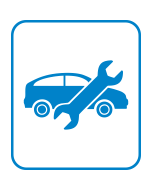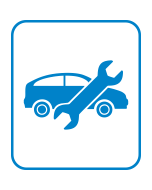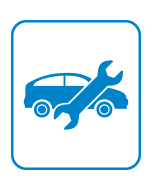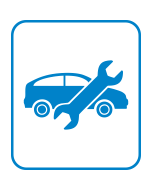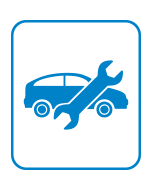Strategic Analysis of Malaysian Commercial Vehicle Industry, Forecast to 2025
Strategic Analysis of Malaysian Commercial Vehicle Industry, Forecast to 2025
Annual Demand for Pickups, Light-medium-heavy Trucks and Buses to Grow With Infrastructure Growth and Entry of New Players by 2025
27-Feb-2018
Asia Pacific
$3,000.00
Special Price $2,250.00 save 25 %
Description
Malaysia is the third largest commercial vehicle (CV) market in Asia Pacific after Indonesia and Thailand and is at the beginning of a rapid growth phase. The Total Industry Volume (TIV) has continued to decrease since 2013 due to slow economic growth and a depreciating Ringgit that has impacted business confidence and purchasing power. Consequently, production has also declined over the years. Pickups account for the largest segment, in terms of both sales and production.
Japanese brands have the widest CV distribution and service network in Malaysia. During the forecast period, the Malaysian CV market is expected to experience positive growth despite challenges related to the depreciating Ringgit value and price hike, import of rebuilt trucks and stringent credit approval criteria. Due to the economic crisis in 2015, Malaysia’s GDP growth declined from 6% in 2014 to 5% and then 4.5% in 2015 and 2016, respectively. The Consumer Price Index rose to 5.1% in March 2017, recording its highest level in eight years. Higher retail fuel prices have increased inflation. The biggest sector that has been affected is transport, with an increase of 23% when compared on a year-to-year basis. Besides, in 2015, the Ringgit depreciated against the USD, EURO, THB, JPY, CNY and IDR. This, together with its slow improvement in 2016, also hindered customers’ decision to purchase new vehicles/fleets.
However, OEMs can overcome these challenges due to the various trends supporting the growth of the CV market. These include migration of C-segment users to the pickup segment, continuous infrastructure projects and market penetration by new players. Since 2015, there has been a significant increase in preference for pickups as opposed to C-segment vehicles. It is likely that this migration has been triggered by the multiple functionality that pickup trucks offer, the increased number of entrepreneurs in this space, and the availability of reasonably priced pickup trucks. Many OEMs are taking advantage of this trend by offering multiple variants and facelift models. Reliability and high resale value are among the factors that are contributing to the high demand for pickup trucks in Malaysia.
Research Scope
This study aims to research, analyze and forecast the commercial vehicles market in Malaysia during 2012-2025. The scope of the study includes:
- Strategic overview of the CV market, including key technology trends, market trends, and market drivers and restraints
- Market size and forecasts for pickups, light trucks, medium trucks, heavy trucks and bus segments by OEM and sales breakdown for 2012–2016
- Current and future forecasts by segments until 2025
- Competitor analysis, including competitive factors, competitor market shares, and product portfolio analysis and capabilities
- Analysis of OEM’s perspective of the CV market
Key Issues Addressed
- How is the business environment of the automotive industry impacting the sales of CVs?
- How are CVs classified and how is the market structured?
- Who are the market leaders and what are their market shares?
- What are the technology trends?
- Is there potential for growth within the market?
RESEARCH: INFOGRAPHIC
This infographic presents a brief overview of the research, and highlights the key topics discussed in it.Click image to view it in full size
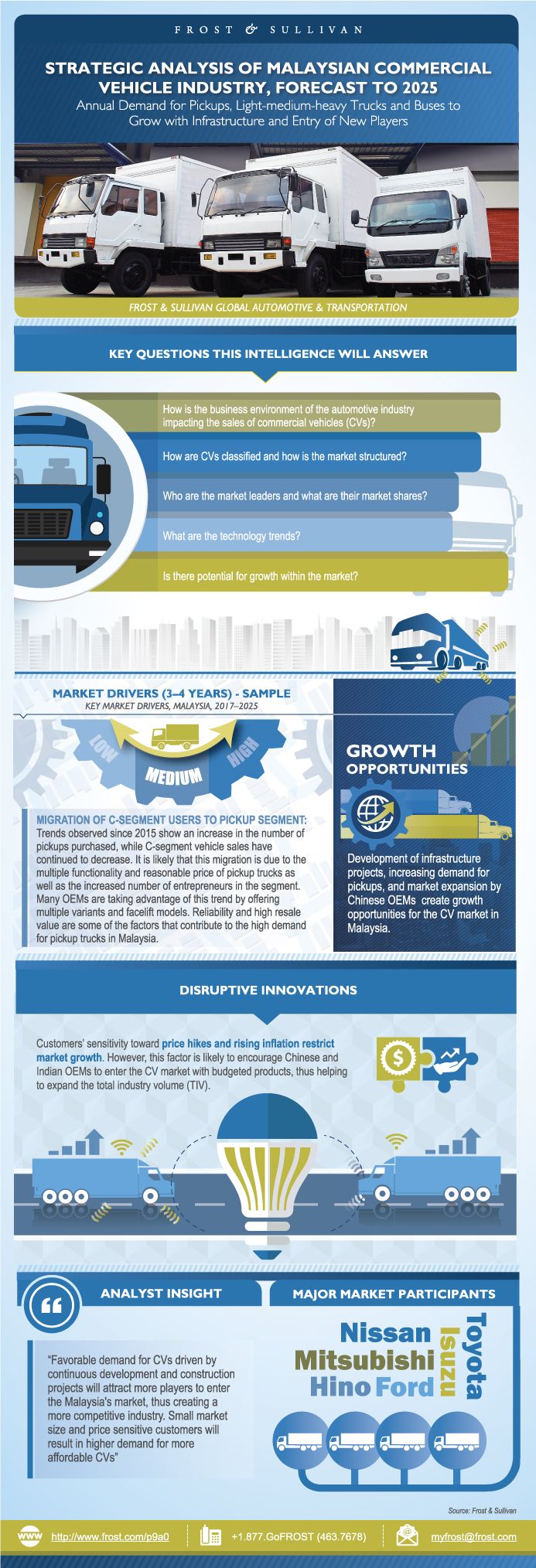
Table of Contents
Market Engineering Measurements
Total Commercial Vehicles Market Sales Snapshot
Competitive Environment—Commercial Vehicles Market
Market and Technology Trends
Total Commercial Vehicles Market—Sales Scenario Analysis
Research Scope
Research Aims and Objectives
Key Questions this Study Will Answer
Research Methodology
Key OEM/Participant Groups Compared in this Study
Vehicle Definitions
Vehicle Segmentation
Commercial Vehicles Market—Sales Breakdown by Segments
Commercial Vehicles Market—Sales Breakdown by Brands
Commercial Vehicles Market—Sales Breakdown by States
Commercial Vehicles Market—Production Breakdown by Segments
Commercial Vehicles Market—Production Breakdown by Brands
Powertrain Mix by Fuel Type
Commercial Vehicles Age Analysis
Commercial Vehicles Age Analysis—New Versus Used
Commercial Vehicles Fleet Type and Size
Malaysian Commercial Vehicles Market—Lifecycle Analysis
The Malaysian Commercial Vehicles Industry—Outlook of Value Chain by 2025
Applications of Commercial Vehicles by Fleet Type
Commercial Vehicles Market—Dealership Analysis
Commercial Vehicles Market—Dealership Analysis by State
Commercial Vehicles Market—Major Dealers
Emission Norms and Legislations
Applicable National Standards / Global Standards
Safety and Fuel Efficiency Regulations
Key Industries Impacting Malaysia’s Commercial Vehicle Market
Key Industries Impacting Malaysia’s Commercial Vehicle Market (continued)
Agriculture Industry—Development and Impact
Agriculture Industry—Future Growth
Manufacturing Industry—Development and Impact
Manufacturing Industry—Future Growth
Construction Industry—Development and Impact
Construction Industry—Future Growth
Market Drivers
Drivers Explained
Drivers Explained (continued)
Market Restraints
Restraints Explained
Restraints Explained (continued)
Market Engineering Measurements
Total Commercial Vehicles Market—Sales Scenario Analysis
Total Commercial Vehicles Market—Optimistic Scenario Analysis
Total Commercial Vehicles Market—Frost & Sullivan Scenario Analysis
Total Commercial Vehicles Market—Conservative Scenario Analysis
Total Commercial Vehicles Market Sales Snapshot
Competitive Environment—Commercial Vehicles Market
Pickup Segment—Unit Sales by OEMs
Pickup Segment—Competitive Environment
Pickup Segment—Key Best Selling Models
Small Commercial Vehicle Segment— Unit Sales by OEM
Small Commercial Vehicle Segment—Competitive Environment
Small Commercial Vehicle Segment—Key Best Selling Models
Light Truck Segment—Unit Sales by OEM
Light Truck Segment—Competitive Environment
Light Truck Segment—Key Best Selling Models
Medium Commercial Vehicle Segment—Unit Sales by OEM
Medium Commercial Vehicle Segment—Competitive Environment
Medium Commercial Vehicle Segment—Key Best Selling Models
Heavy Commercial Vehicle Segment—Unit Sales by OEM
Heavy Commercial Vehicle Segment—Competitive Environment
Heavy Commercial Vehicle Segment—Key Best Selling Models
Light Bus Segment—Unit Sales by OEM
Light Bus Segment—Competitive Environment
Light Bus Segment—Key Best Selling Models
Medium/Heavy Bus Segment—Unit Sales by OEM
Medium/Heavy Bus Segment—Competitive Environment
Medium/Heavy Bus Segment—Key Best Selling Models
Top Market Participants
Top Market Participants (continued)
Manufacturing Locations
Commercial Vehicles Manufacturers—UMW Holdings Berhad
Commercial Vehicles Manufacturers—Isuzu Malaysia Sdn Bhd
Commercial Vehicles Manufacturers—Tan Chong Motor Holdings Berhad
Commercial Vehicles Manufacturers—Sime Darby Berhad
Commercial Vehicles Manufacturers—Hino Motor Sales (M) Sdn Bhd
Recent Activities
Recent Activities (continued)
Recent Activities (continued)
Growth Opportunity 1—Infrastructure Projects
Growth Opportunity 2—Increasing Demand for Pickups
Growth Opportunity 3—Market Expansion by Chinese Companies
Growth Opportunity 4—Growth in Manufacturing Industry
Strategic Imperatives for Success and Growth
Key Conclusions and Future Outlook
Strategic Recommendations for Global OEMs
Commercial Vehicle Market—Recommended Dealership Locations
The Last Word—3 Big Predictions
Legal Disclaimer
List of Exhibits
List of Exhibits (continued)
List of Exhibits (continued)
List of Exhibits (continued)
List of Exhibits (continued)
List of Exhibits (continued)
Table of Acronyms Used
Table of Acronyms Used (continued)
Popular Topics
| No Index | No |
|---|---|
| Podcast | No |
| Author | Nur Afiqah Mohamad |
| Industries | Automotive |
| WIP Number | P9A0-01-00-00-00 |
| Is Prebook | No |
| GPS Codes | 9673-A6,9800-A6,9963-A6,9AF6-A6,9B01-A6 |
 USD
USD GBP
GBP CNY
CNY EUR
EUR INR
INR JPY
JPY MYR
MYR ZAR
ZAR KRW
KRW THB
THB
